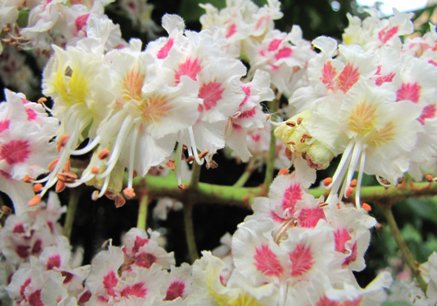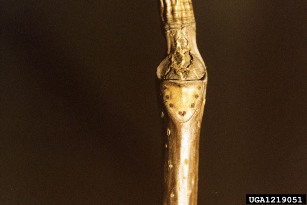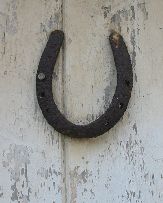Adaptation
LEAVES -
The horse chestnut tree derives its nutrients and energy from
photosynthesis. For more on this process see Nutrition.
Therefore, it is very important that the efficiency and amount
of photosynthesis being done is maximized.
 All throughout
the plant kingdom we see adaptations to increase the surface
area of photosynthetic areas of the plants. In
Aesculus hippocastanum, this increased surface area is seen
in the unique and aesthetic leaves. The leaves are
palmately compound, meaning that they have multiple leaflets
coming from one single point at the point of the petiole.
Horse chestnut leaves usually contain about 7 leaflets which
usually display more chlorophyll on the side facing upwards than
on the bottom side. This is due to the greater quantity of
light received by the top surface. The leaflets are
usually 10 to 20 cm (approx. 4-8 in) long. This provides more than adequate
surface area on which light can be received to undergo
photosynthesis.
All throughout
the plant kingdom we see adaptations to increase the surface
area of photosynthetic areas of the plants. In
Aesculus hippocastanum, this increased surface area is seen
in the unique and aesthetic leaves. The leaves are
palmately compound, meaning that they have multiple leaflets
coming from one single point at the point of the petiole.
Horse chestnut leaves usually contain about 7 leaflets which
usually display more chlorophyll on the side facing upwards than
on the bottom side. This is due to the greater quantity of
light received by the top surface. The leaflets are
usually 10 to 20 cm (approx. 4-8 in) long. This provides more than adequate
surface area on which light can be received to undergo
photosynthesis.
 FRUITS -
FRUITS -
The fruits of the horse chestnut are disputably the most
interesting features of the tree, though not completely unique
to this species. They are highly adapted to provide
support and protection for the encased embryo. One
characteristic of the seed that contributes to this protection
is the spines that coat the outside of the seed. Secondly,
not only are the seed coverings very hard, the seeds themselves
are very resistant. In fact, there is an entire sport
based off trying to break these seeds. For more on these
games see Interactions. Another level of protection these fruits
provide for the enclosed embryos is the toxin it contains to
avoid predation. For more on this toxin see Health & Horse
Chestnuts.
SECONDARY GROWTH -
Secondary growth is the phenomenon in which plants increase in
girth, not height. This process begins with the
procambium
growing together to make a concentric path around the length of
the trunk.  This
new layer is called the vascular cambium and ultimately excretes
the secondary xylem towards the pith of the tree and the
secondary phloem towards the bark. As time progresses the
xylem takes up a continuously larger amount of area and forces
the vascular cambium to continuously get grow outwards.
Therefore, if you could observe the layers of the trunk of the
horse chestnut tree from the outside to the center you would
first see the bark including the secondary phloem, the vascular
cambium, the secondary xylem, and then the pith of the tree.
This ability is shared among dicots and gymnosperms.
Plants with secondary growth are allowed much more support and
protection than those with only primary growth.
This
new layer is called the vascular cambium and ultimately excretes
the secondary xylem towards the pith of the tree and the
secondary phloem towards the bark. As time progresses the
xylem takes up a continuously larger amount of area and forces
the vascular cambium to continuously get grow outwards.
Therefore, if you could observe the layers of the trunk of the
horse chestnut tree from the outside to the center you would
first see the bark including the secondary phloem, the vascular
cambium, the secondary xylem, and then the pith of the tree.
This ability is shared among dicots and gymnosperms.
Plants with secondary growth are allowed much more support and
protection than those with only primary growth.
 FLOWERS -
FLOWERS -
In general, flowers are in angiosperms and function as
reproductive organs. The horse chestnut blooms in spring
with large white flowers with yellow and/or red spots. The
flowers are arranged into a "spike" measuring to about 5 to 13
cm (approx. 2-5 in) wide and 13 to 30 cm (approx. 5-12 in) high.
Each individual flower consists of 5 petals. These flowers
usually appear in May and final development and ripening of the
seeds begins in late August or early September. This
adaptation not only supplies us with an aesthetic tree, but
attract pollinators and are the sites of eventual fertilization
of the egg by the sperm. If you think these flowers
are pretty, take a look at the flowers on
Kiwifruit!

